Camail
Camail is in Armour.
Camail. Sometimes 'aventail'. A camail is chain-mail that hangs from a bascinet.
Around 1340 the Camail and Jupon Period starts; around the time of the commencement of the Hundred Years War. Knights wear a bascinet with camail and a jupon. The Camail and Jupon Period is also characterised by the heavy belts slung low on the hips from which the sword was slung. Effigies of this period are characterised by having facial hair, and their hands clasped in prayer on the chest. Male effigies of this period have their head resting on Great Helms usually surmounted by their Crest.
After 10 Jul 1359. Monument to William Greystoke 2nd Baron Greystoke (deceased) in St Andrew's Church, Greystoke [Map]. Camail and Jupon Period. On his head he wears the bascinet with a camail. The jupon under which his coat of chain mail may be seen. His sword belt is low on his jupon, horizontal.
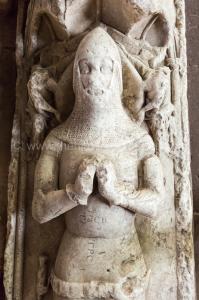
After 01 Sep 1414 William Ros 6th Baron Ros Helmsley (age 44) was buried at Belvoir Priory [Map]. At the dissolution of the monasteries his monument was moved to the Chancel of St Mary the Virgin Church, Bottesford, Leicestershire [Map] on the right side of the High Altar. Alabaster Monument of the Camail and Jupon Period. Possibly Sutton and Prentys.
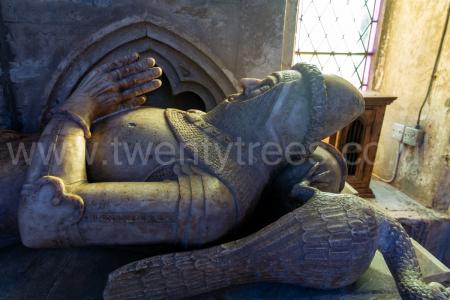
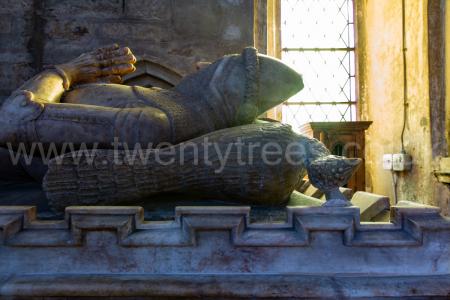
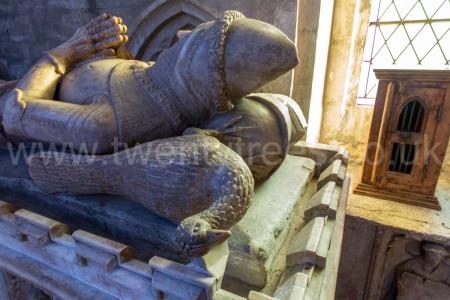
Detail of the Ros Family Peacock Crest surmounting his Great Helm.
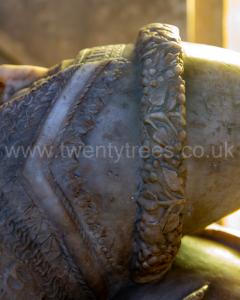
Detail of decorated Orle and Vervelle Cover.
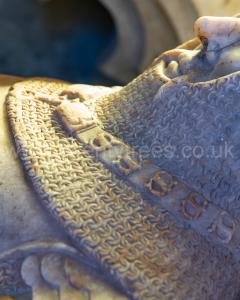
Detail of Lancastrian Esses Collar and face. Note the twisted moustache that is frequently seen on Sutton and Prentys monuments. The fixing of the Esses Collar to the Camail using a small trefoil.
After 22 Mar 1421 John Ros 7th Baron Ros Helmsley (age 24) was buried at Belvoir Priory [Map]. His remains and monument were subsequently relocated to the Chancel of St Mary the Virgin Church, Bottesford, Leicestershire [Map]. Early Plate Bascinet Period.
John Ros 7th Baron Ros Helmsley:
Around 1397 he was born to William Ros 6th Baron Ros Helmsley and Margaret Fitzalan Baroness Ros of Helmsley.
On 01 Sep 1414 William Ros 6th Baron Ros Helmsley died. His son John Ros 7th Baron Ros Helmsley succeeded 7th Baron Ros Helmsley.
Before 22 Mar 1421 John Ros 7th Baron Ros Helmsley and Margery Despencer 3rd Baroness Despencer, Baroness Ros were married. She by marriage Baroness Ros Helmsley. They were third cousins. He a great x 4 grandson of King Henry III of England. 

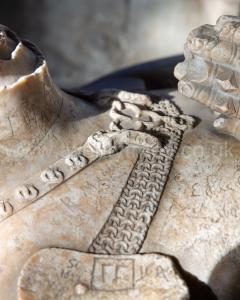
Detail of Lancastrian Esses Collar and the trefoil fixing holding the Lancastrian Esses Collar to the bottom of the Camail.
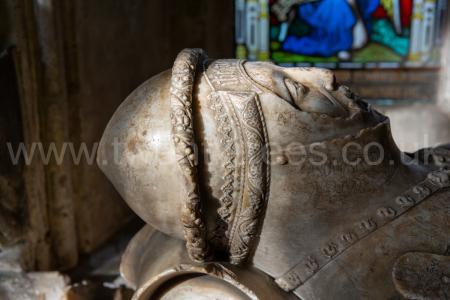
Detail of IHC NASARE Lettering and Decorated Orle and decorated Vervelle Cover. Bascinet with Gorget. Lancastrian Esses Collar.
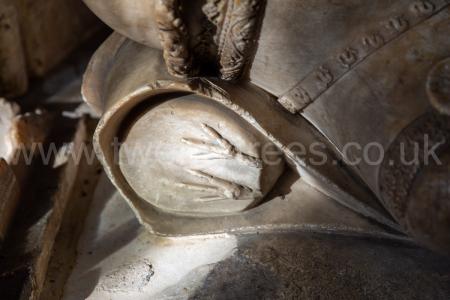
Detail of the Ros Peacock Crest which surmounted his Great Helm; only the feet remain.
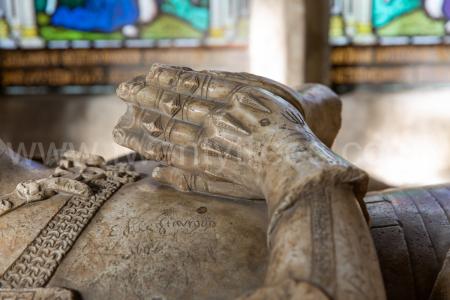
Detail of the Hourglass Gauntlets and graffiti.
In 1436 John Greystoke 4th Baron Greystoke (age 47) died. He was buried at St Andrew's Church, Greystoke [Map]. His son Ralph Greystoke 5th Baron Greystoke (age 22) succeeded 5th Baron Greystoke. Monument in St Andrew's Church, Greystoke [Map]. Fluted Period. His Pauldrons are unusual in their style. His arms are fully encased in plate with a couter (or coude) protecting the elbow joint. Fine detail of the straps that held the armour in place may be seen on the underarms. A gorget, has replaced the camail. His head is, very unusually, bare as is his face, his hair cut in the style so typical of portraits of Henry V. The effigy was possibly made somewhat after John's death or, possibly, that the effigy has been incorrectly assigned. His head rests on the decorated tournament helm. He wears the Lancastrian Esses Collar. John had supported the usurpation of Richard II by Henry IV in the 1390s; staunch Lancastrians. John had married, in 1407, Elizabeth Ferrers, daughter of Joan Beaufort, daughter of John of Gaunt, son of King Edward III. Two sword belts: diagonal (bawdric) and horizontal. The jupon, beneath the waist has been replaced by a fauld; horizontal strips of metal that wrap around.
John Greystoke 4th Baron Greystoke: In 1389 he was born to Ralph Greystoke 3rd Baron Greystoke and Catherine Clifford Baroness Greystoke. On 28 Oct 1407 John Greystoke 4th Baron Greystoke and Elizabeth Ferrers Baroness Greystoke were married at Greystoke Castle, Cumberland. She by marriage Baroness Greystoke. She the daughter of Robert Ferrers and Joan Beaufort Countess of Westmoreland. She a great granddaughter of King Edward III of England. On 06 Apr 1418 Ralph Greystoke 3rd Baron Greystoke died. He was buried at Newminster Abbey. His son John Greystoke 4th Baron Greystoke succeeded 4th Baron Greystoke.
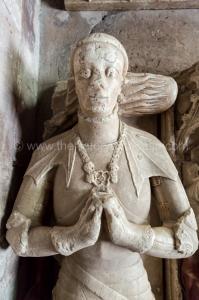
Introduction. "The camail was originally a covering of mail for the head, and was called capmail, the basinet being worn over it; but about 1330 its form was materially altered: it no longer extended as a covering for the head; vervilles or staples, were introduced on the basinet, and the camail fastened outside, by means of these and a lace. We have some few instances, about the period that this change took place, where the ends of the mail, at its junction with the basinet, are left folding over the lacing, and depending on each side in an ornamental form. The camail was often called the barbiere, or the gorgerette, after the changes took place; but as there is more consistency in Froissart, in his descriptions of armour, I have preferred that name by which he invariably distinguishes this appendage to the basinet. The lacing of the helmet to the cervelliere appears to have been first disused in all those monuments of the time of Henry the Fourth, and was never afterwards resumeda.
Note a. Ibid. p. 332.
Introduction. The third period inclosed the body from head to loot in plate of steel, and the chain-mail only makes its appearance at the or armpit joints of the armour, either as gussets, or worn under-neath, as a haubergeon, or lighter shirt of maila. The camail, or gorget of mail, so called from its being attached by a lace to the basinet, or cap, was, on account of the pliability which it afforded to the motion of the neck, at first retained, but was ultimately displaced by a gorget of plate. To the breastplate the protuberant form of a pigeon's breast was given, particularly well calculated to glance off the thrust of a spear, and to prevent the body from being injured by blows causing deep indentations in the armour. The term hauberk seems to have been used either for the corselet, or body-armour of mail or of plate. Chaucer thus describes the armour of a knight, in his 'Rhime of Sir Thopas':
'He did on next his white lere
Of cloth of lake full line and clere,
A breche, and eke a sherte.
And next his sherte an hakaton,
And ovir that an hagergeon
For percing of his herte;
And over that a fine hauberke
Was all ywrought of Jewis werke;
Full strong it was of plate.
And ovir that his cote-armure.
As white as is the lilly-floure.
In which he would debate.
His shelde was all of gold so redde
And thereon was a boris hedde;
A carboncle beside.
* * * * * *
His jambeux were of cure bulyb;
His swordis shethe of ivory;
His helm of laton bright;
His sadell was of ruell bonec;
His bridle as the sunne yshone.
Or as the moone ylight;
His spere was of the hne cypres.
That bodeth warre, and nothing pece.
The hedde full sharpe igrounded."
Note a. In Dr. Mcyrick's line collection of ancient arms and armour, we see a figure wearing the habergeon of mail over the hauberk of plate. This does not appear to accord with the arrangement of the harness on Chaucer's night; but both modes were no doubt adopted, according to the pleasure of the wearer.
Note b. Cuir bouilli was extensively used in armour. The corselet, or body-armour, superadded to the hauberk, was at first composed of it, and in the term cuirass we have etymological record that it was so employed; and plastron implies a defence of leather, sitting as close to the breast as a plaister. The figure of John of Eltham may be considered to afford a good example of plate and leather-armour intermixed. Du Cange, in his Notes on Joinville, cites a very curious inventory of the armour necessary for a knight, which will be found to corroborate the above remarks: "Premierement, un harnois de jambes covert de cuir comme a esguillettes, ou long de la garnbe jusques au genouïl, et deux attaches large pour son barrueir (breeches), et souleres values (qu. velours?) attaches au gruës (greaves).
"Item. Cuisses et poullains (knee-plates) de cuir, armoiez de Varennes, des armes au chevalier.
"Item, un chausse de mailles par-dessus le harnois de jambes, attachée au braier, comme dit est par-dessus les cuisses (this was, perhaps, the gipon, jupon, or little petticoat of mail), et uns esperons dorez qui sont attachez a une cordelette autour de la jambe, afin que la molette (rowel) ne tourne dessous le pied.
"Item, pans et manchez, qui sont attachez a la cuirie (cuirass, leather corselet) a tous ses esgrappes sur les espaules, et un seursliere (sous cervelliere or camail) sur le pis (breast) avant.
"Item, bracheres a tout le harnois (qu. bracers or straps for the whole harness?) et le han escucon de la banniere sur le col (shield of his banner or arms slung from the neck), couvert de cuir, avec les tonnerres pour les attacher au braier a la cuirie, et sur le bacinet une coiffe de mailles, et un bel orfroy par devant le front qui veut (qu. a circlet ornamented in front with goldsmiths' work; see effigy of William de Valence).
"Item, bracellets attachez aux espaules de la cuirie (qu. brassarts, arm-plates, fastened to the cuirass at the shoulders?)
"Item, un gaigne pain pour mettre es mains du chevalier (a sword for the knight's hand, here called by a nickname in general use, a 'bread-earner').
"Item, un heaume et le tymbre (crest), tel comme ll voudra.
"Item, deux chains a attachier a la poitrine de la cuirie, une pour Tepee, Tautrepour le baston, en deux vigeres, pour le heaume attacher. (Two chains; one to fasten the sword to the breast of the cuirass, another having some contrivance of a stick to attach the helmet in the same way.)
Note c. Ruell-bone; bone or stained with divers colours.
Note d. The following passage of Froissart will afford an idea of the power of a sharp-ground lance: "Among the Cambresians was a young squire from Gascony, called William Marchant, who came to the held of battle mounted on a good steed, his shield hanging to his neck, his lance in its rest, completely armed, and spurring on to the combat. When Sir Giles Manny saw him approach, he spurred on to meet him most vigorously, and they met, lance in hand, without fear of each other. Sir Giles had his shield pierced through, as well as all the armour near his heart, and the iron passed quite through his body."—Johnes's Translation, 8vo, vol. 1. p. 169.